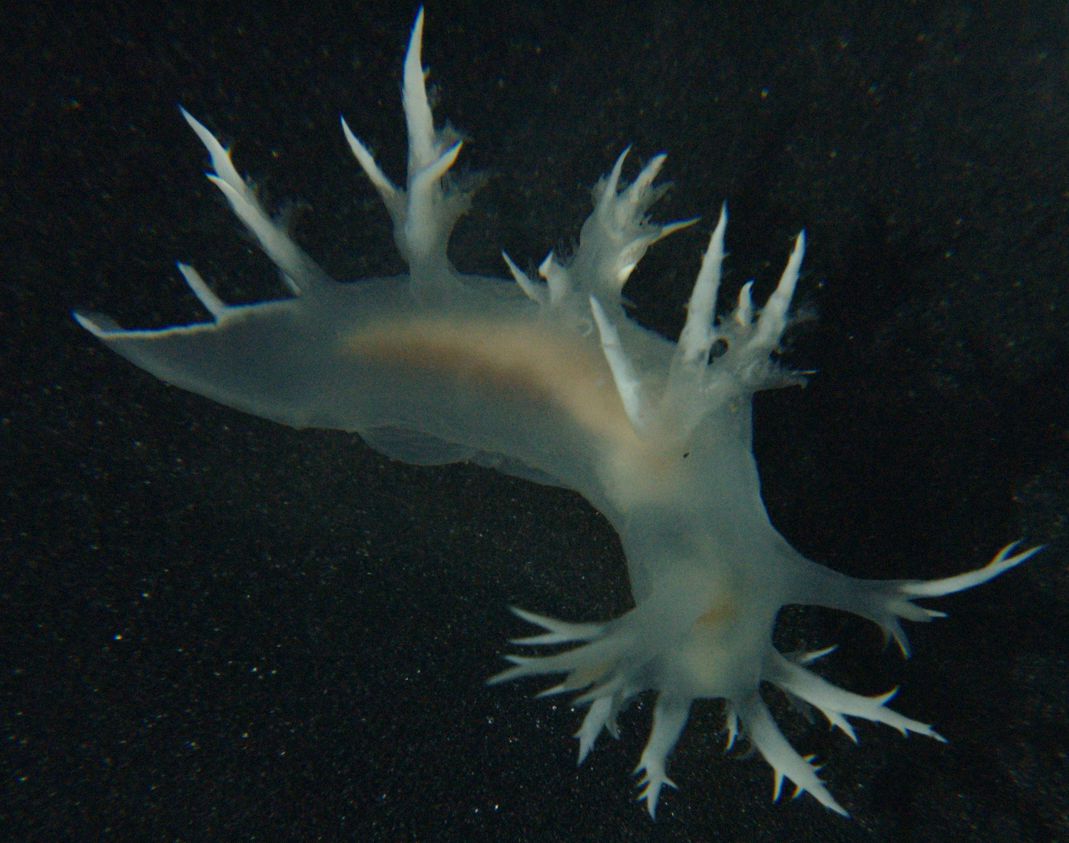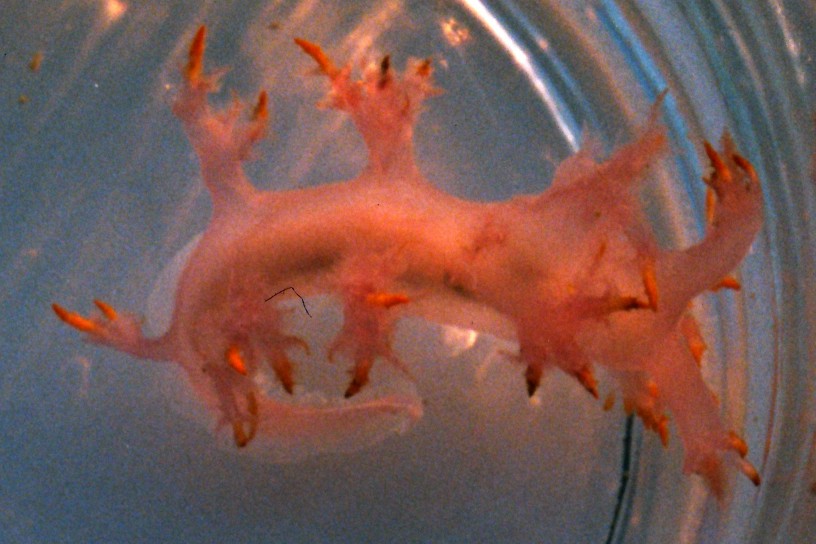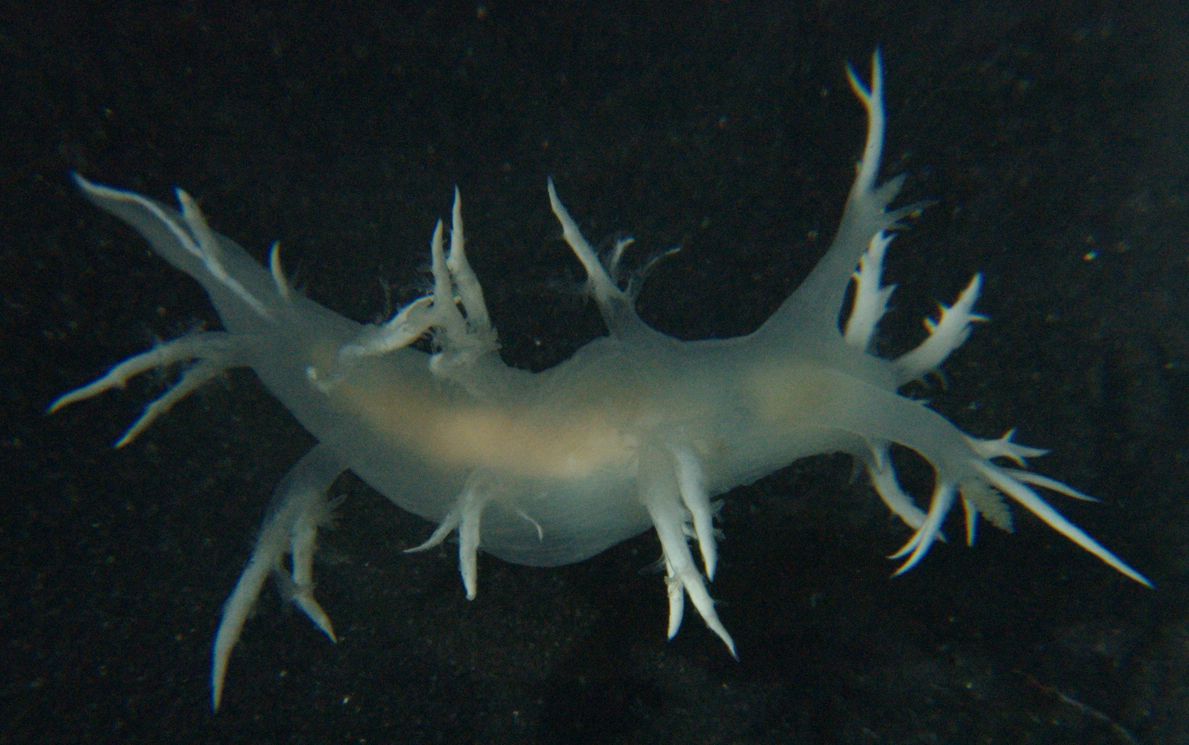Dendronotus albus MacFarland, 1966Common name(s): White dendronotid, white frond-aeolis |
|
| Synonyms: |  |
|
Class Gastropoda
Family Dendronotidae
|
|
| Dendronotus albus, about 4 cm long, found subtidally off Sares Head. Note that the dorsomedial white line on the tail extends forward past the last cerata. | |
| (Photo by: Dave Cowles, August 2014 ) | |
Description: Dendronotids have the anus on an inconspicuous papilla in the anterior half of the right side of the dorsum, usually among the cerata. They have fanlike branched cerata on the dorsum, which are usually numerous and in transverse rows. The clavus of the rhinophores is not retractile into a sheath. D. albus has a slender, sluglike body with 5-8 pairs of moderately branched cerata in longitudinal rows, no oral hood, large, prominent rhinophores with a perfoliateclavus and a sheath drawn out into 4-10 papillae that make it look crownlike; the oral veil only slightly overhangs the mouth but has 2-3 pairs of branched papillae. The foot has no white line around its margin. The body is translucent white, usually with strong white pigment on the tips of the cerata, on the stalk and crown of the rhinophores, and on the veil papillae and lateral papillae. Sometimes the cerata are tan at the base, and they may be orange, red, or brown rather than white at the tip. May have a few conical papillae on the dorsum besides the cerata. Has a dorsomedial white line from the tip of the tail, past the posteriormost pair(s) of cerata and up to the 4th or sometimes even the 2nd pair (see photo above). Up to 4.5 cm long, but usually 1-3 cm.
How to Distinguish from Similar Species:Dendronotus diversicolor may be white but it has only four pairs of cerata, the dorsomedial white line on the tail only extends up to the last pair of cerata, and the dorsum has no papillae. Dendronotus frondosus has no white line on the tail.
Geographical Range: Kenai Peninsula, Alaska to the Pacific coast of Baja California, Mexico
Depth Range: Intertidal to 30 m
Habitat: On rocks, generally near hydroids, especially in currents.
Biology/Natural History: This species
feeds on thecate hydroids such as Abietenaria, Tubularia
and Plumularia. Seems
to be most commonly found in fall and winter in the northern part of its
range. Eggs are laid as a band on the tips of hydroids in October
and November in Washington. This species is a good swimmer.
| Return to: | |||
| Main Page | Alphabetic Index | Systematic Index | Glossary |
References:
Dichotomous Keys:Carlton, 2007
Kozloff, 1987, 1996
General References:
Behrens
and Hermosillo, 2005
Harbo,
2011
Lamb
and Hanby, 2005
Morris
et al., 1980
Scientific Articles:
Web sites:
General Notes and Observations: Locations, abundances, unusual behaviors:
Another view of the same individual as above.
| The photos below show another color phase of this species, which was formerly regarded as a separate species Dendronotus diversicolor. |
 |
| Photos by Dave Cowles. Above, 1997. Below, 2014 |
 |
Authors and Editors of Page:
Dave Cowles (2014): Created original page
CSS coding for page developed by Jonathan Cowles (2007)
Salish Sea Invertebrates web site provided courtesy of Walla
Walla University
